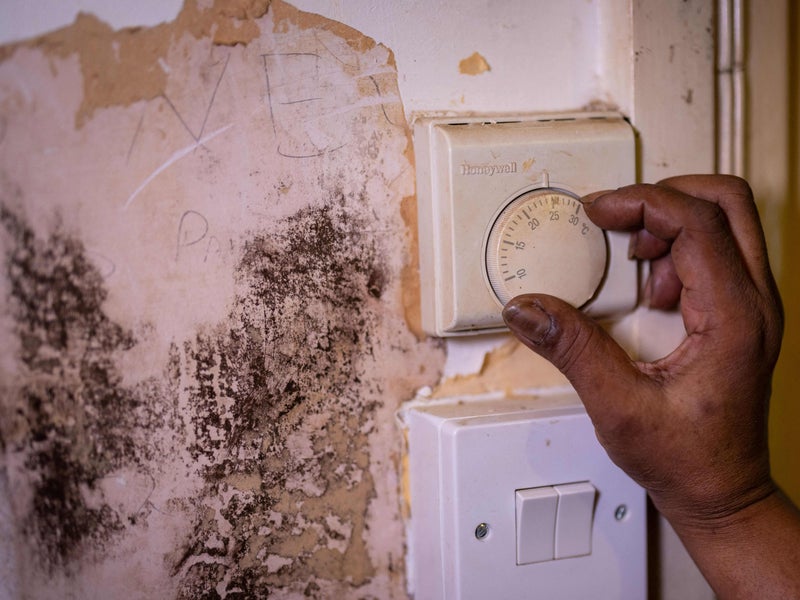MOULD in your home can lead to a whole range of problems, including health issues if it's not dealt with fast. However, there's a simple hack that will stop it from ever forming in the first place - and the best part is it won't cost you a penny. According to data from MyBuilder.com, 24% Brits have seen higher levels of mould than in previous years. But fear not, a little-known German method could be the faff-free solution you've been looking for.
![[two potted plants are sitting on a table next to pillows]](https://www.thesun.co.uk/wp-content/uploads/2024/10/many-colored-wear-steel-radiator-939284411.jpg?strip=all&w=960)
The technique, which translated to 'shock ventilation' basically means you open your windows a few times per day, but only for a short spurt of time. This might not sound ideal in the current cold weather, but doing to several times for a few minutes can make all the difference when it comes to mould forming. This is because mould mostly forms in damp environments, so keeping windows closed forms the perfect climate for mould to thrive, especially if you're drying clothes or have a lot of people in each room.
![[Spray bottle and sponge near black mould wall. House cleaning concept]](https://www.thesun.co.uk/wp-content/uploads/2024/10/mould07jpg-JS781486932.jpg?strip=all&w=960)
Proper ventilation is the key to stopping mould in it's tracks, which is why this German method could be the answer you've been looking for. It's the best of both worlds because you don't have to keep your windows open for long periods of time, which might result in all the heat escaping your home, but you still get to let in enough fresh air to ventilate the space. Of course, there are a few other simple hack to keep mould at bay too.
Although most of us tend to associate mould with black dots scattered all over the walls, sometimes it can be right under your feet - quite literally. “Carpets are extremely porous, meaning if they get wet, they’re likely to hold the water – which will create the perfect environment for mould to grow,” warned Radiator expert Nancy Emery. To prevent a build-up, the guru noted that ''it’s crucial to invest in high quality carpet padding which has antimicrobial properties''.
Although it's more on the expensive side, it will be a worthwhile investment in the long run - and don't forget to regularly vacuum or get the carpets professionally cleaned every now and then. Condensation is another common issue for Brits during the colder months - and it can lead to mould. While it can definitely be tempting to sleep with your windows closed, according to the pro keeping your bedroom windows slightly ajar is a great way to reduce the humidity.
Another must-do on the list includes ensuring there is enough room for air to flow freely between the external wall and furnishings, the expert noted. Simply by positioning your furniture away from external walls you can greatly reduce the amount of condensation and risk of dampness. By now, you've probably heard about dehumidifiers at least dozens of times - and rightly so, as these nifty devices are a game-changer during the cold season.
Available on Amazon, Home Bargains and other stores, these handy gadgets work by removing the water from the air. ''This means that there is no air moisture to condense on surfaces around the home, impeding the growth of dampness and mould around the home,” explained the guru. Chucking your washing on radiators might seem a quick fix for those without a tumble dryer - but using radiators to dry laundry causes a number of issues – including mould and damp.
''The problem with drying clothes on radiators is that it leads to higher amounts of condensation due to the lack of airflow from having your radiators covered, which leaves moisture lingering in your rooms – and that’s when the issues start to arise,” Nancy warned. But if you must dry your soaking wet jeans on a radiator, make sure the windows are open to let the air flow, she added. Mould is more likely to grow during the winter months.
"Unfortunately, mould is a common problem many people face during winter. It thrives in conditions that are warm and damp, so your bathrooms are likely to be the most affected place. "That said, during the colder months most rooms in your home could be vulnerable to mould growing. "This occurs primarily from condensation that builds up on your windows when you’ve got your radiators on. "If you think about it, when windows and doors are closed, there's not much chance for the air to circulate and the moisture to make a swift exit.
"This build up is what can cause dreaded mould to make an appearance, especially in bathrooms, as it creates that warm and wet environment that is a breeding ground for mould. "If left untreated, not only is it unsightly but it can also pose a serious risk to your health, so it’s really important you treat it. "The key to tackle mould is to act fast. "Try to come into as little contact with it as you can. So, grab your gloves, tie up your hair and get to work to remove any signs of mould as soon as you notice them.
























